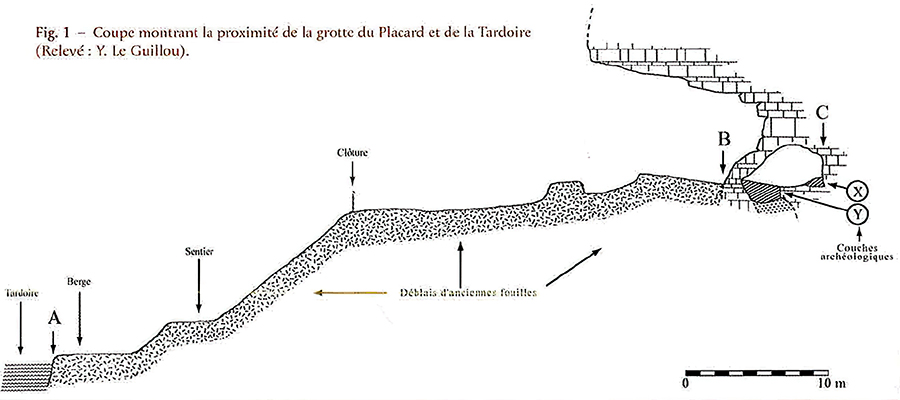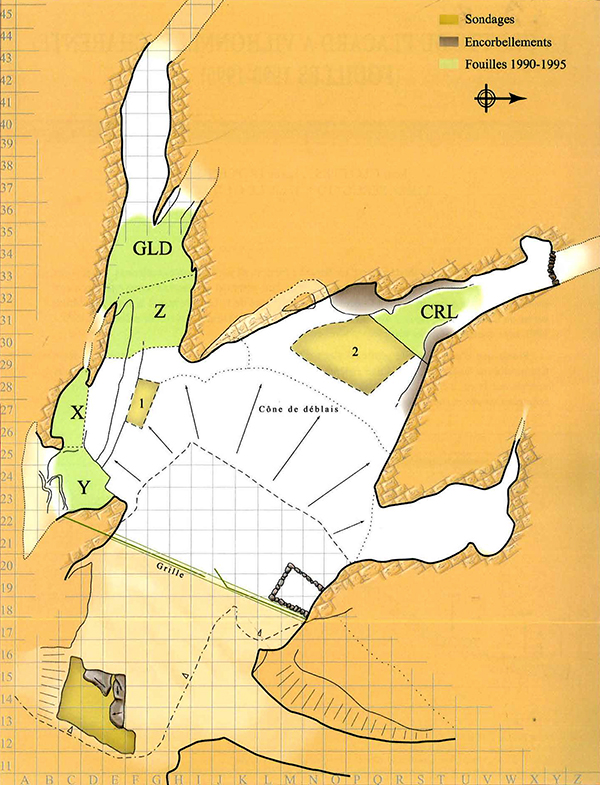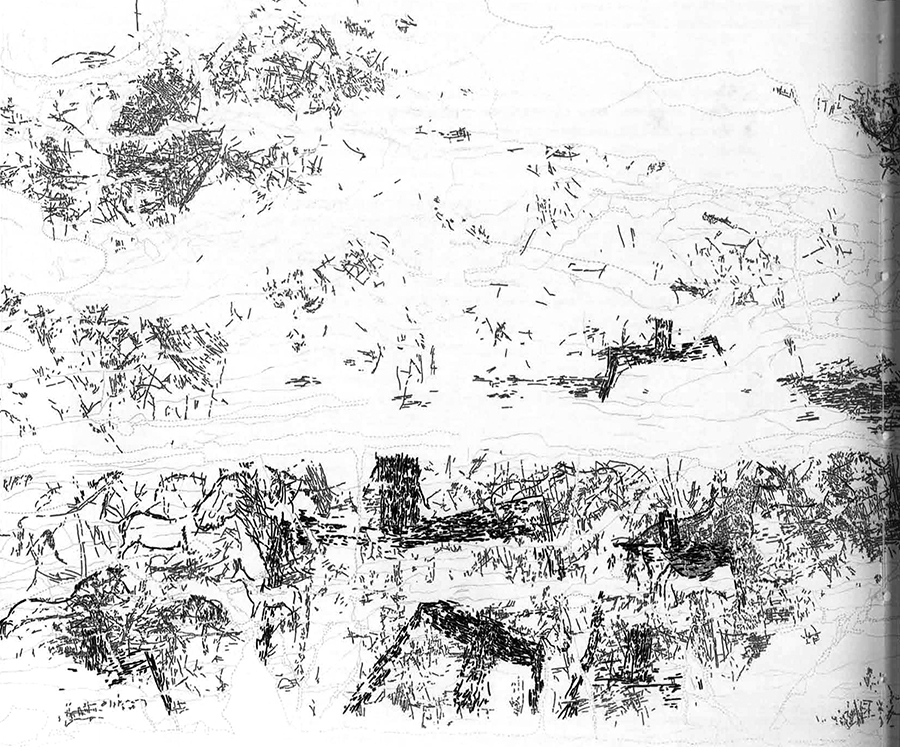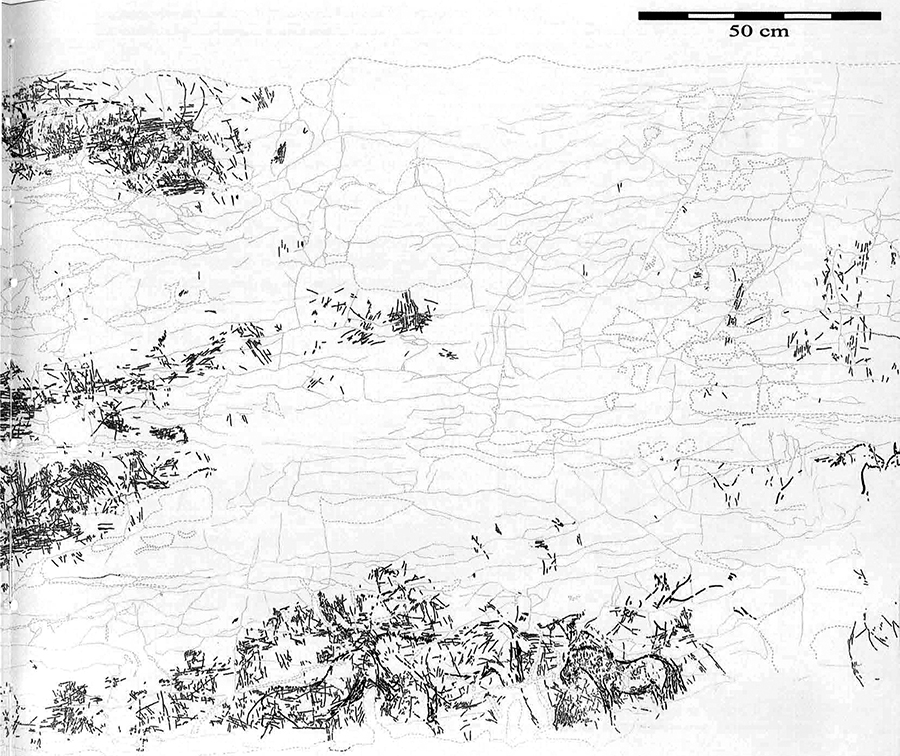Back to Don's Maps
Placard Cave - Grotte du Placard - Grotte de Rochebertier
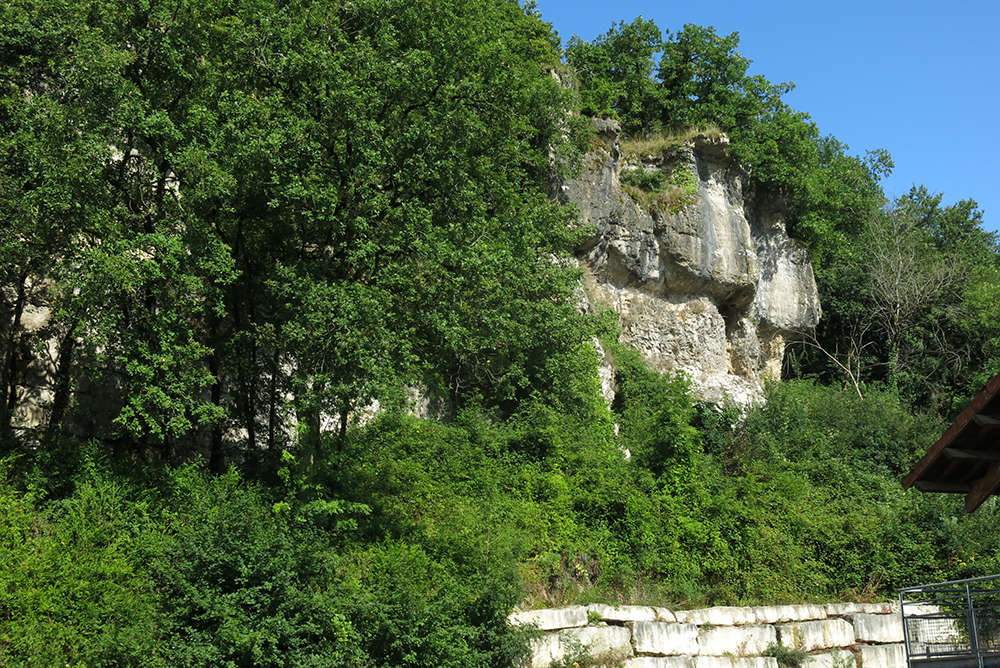
Grotte du Placard
Photo: Don Hitchcock 2014
La grotte du Placard is a decorated cave in the commune of Vilhonneur in Charante, 30 km east of Angoulême. It is situated on the left bank of the Tardoire, in the hamlet of Rochebertier, in a cliff which overlooks the Tardoire. It was discovered around 1853.
It has been extensively researched and has levels dating from the Middle and Upper Paleolithic, especially the Magdalenian and Solutrean. A dozen aviform signs identical to those discovered in the caves of Pech Merle and Cougnac, were unearthed in 1990 on the walls buried in the Solutrean layer, which suggests a cultural grouping or even a common ancestor who visited these caves which are separated by more than 150 km. Similar signs were found in the Cosquer Cave near Marseille, 500 km away. The figures date back about 20 000 years to the Solutrean. The signs are known as Placard type signs.
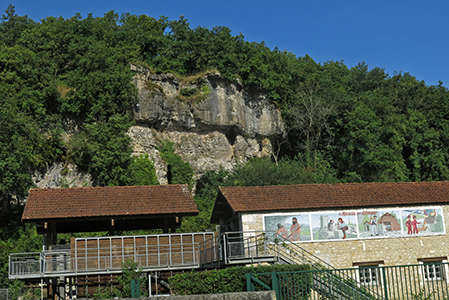
Le Moulin de la Pierre with La Grotte du Placard behind. Le Moulin de la Pierre is a working historical stone cutting workshop, powered by a water turbine.
Photo: Don Hitchcock 2014
Originally called Grotte à Rochebertier by Fermond who discovered it in 1864, the Grotte du Placard is situated on the right bank of the Tardoire, 13 kilometres upstream from La Rochefoucauld.
Carved into a limestone cliff, the entrance to the cave is 17 metres above the river level, with a wide porch giving access to a room 25 metres long and 10 wide at the entrance. It is itself extended to the right by two narrow galleries, and to the left by a more important gallery.
The excavation of the cave, started in 1864 by Fermond, then resumed in 1878 by A. de Maret, continued until the twentieth century. Its stratigraphy comprises the Mousterian, a very significant sequence of Solutrean, then Badegoulian, and virtually all stages of the Magdalenian. As a result of illegal excavations (1986), Duport resumed the excavations in 1988 and the discovery of rock art panels has led to the opening of a rescue campaign by J. Clottes, L. Duport, and V. Feruglio.
Text above from http://solutreen.over-blog.com/3-index.html
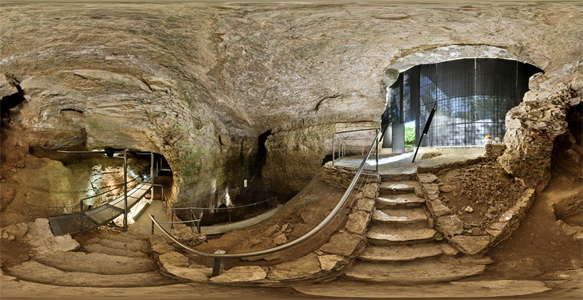
The cave has been beautifully organised for the tourist trade, but entry is free.
Note that the staircase is actually straight, the apparent curve is an artefact of the panorama photo stitching process.
Visitors go to just one very small place in the cave at the foot of the steps, the lit space on the left of the photograph. At this point there are some very small engravings which are very difficult to see, but visitors are not permitted anywhere else in the cave. Take binoculars if you have them in order to see the small engravings from the back of the group.
The visit is entirely in French, delivered at breakneck speed.
Sadly, the cave has been completely excavated.
Photo: http://www.itimedias.fr/pdf/prehistoire.pdf
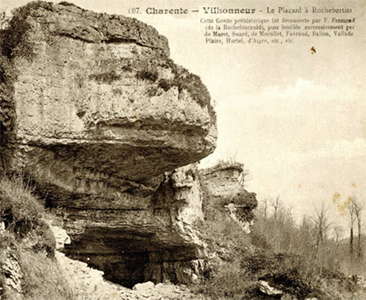
An old postcard of the site at the beginning of the 20th Century.
Photo: http://www.itimedias.fr/pdf/prehistoire.pdf
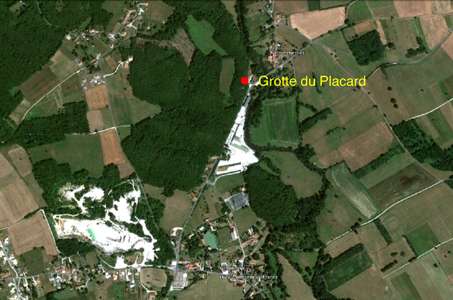
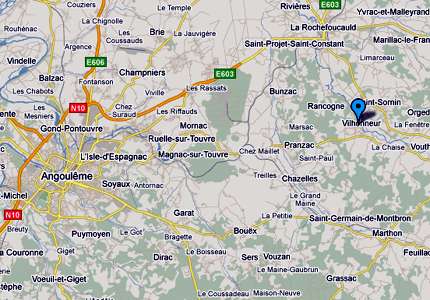
Grotte du Placard near Vilhonneur.
Vilhonneur is east of Angoulême and south of La Rochefoucauld.
Photo: (left) Google Earth
(right) http://www.maplandia.com
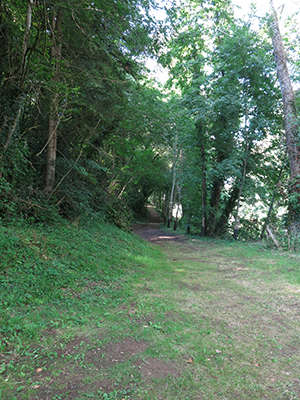
The walk up from the visitors centre to the Grotte du Placard is a pleasant stroll.
Photo: Don Hitchcock 2014
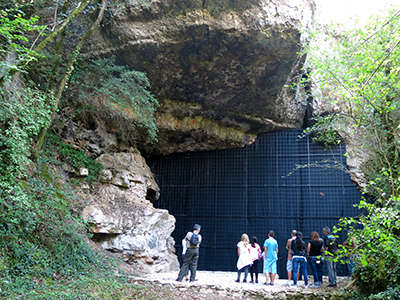
The large entrance has been closed by a grid of steel mesh backed by strong black fabric to keep out the light, while still allowing some movement of air, essential for the health of the cave.
Photo: Don Hitchcock 2014
Cross section showing the proximity of the Grotte du Placard to the Tardoire River.
Drawing: Y. Le Guillou
Source: Clottes et al. (2010)
Plan of the Placard cave and its outer talus slope. Excavations by Clottes et al. (2010) were carried out on X, Y, Z, part of GLD and CRL.
Numbers 1 and 2 indicate deep sondages. The grid is in metres.
Drawing: F. Rouzaud, Y. Le Guillou
Source: Clottes et al. (2010)

Placard bone and antler industry:
Placard spear tip transformed into an intermediate piece, Magdalenian, MN 55 019 j
Facsimile.
Photo: Don Hitchcock 2014
Source: Display, Grotte du Placard

Placard bone and antler industry:
Placard spear tip with a simple bevel base displaying engraved lines, Magdalenian, MAN 55 020.
Facsimile.
Photo: Don Hitchcock 2014
Source: Display, Grotte du Placard

Placard bone and antler industry:
Pendant with notches, Magdalenian, MAN 54 948.
Facsimile.
Photo: Don Hitchcock 2014
Source: Display, Grotte du Placard
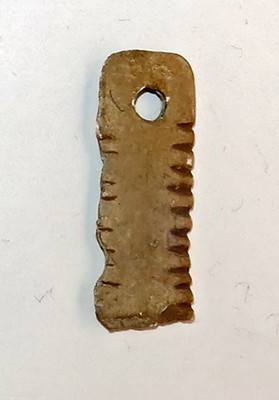
Placard bone and antler industry:
Bone pendant from Placard, 16 000 BP - 18 000 BP.
Photo: Don Hitchcock 2015
Source and text: Facsimile, Monrepos Archäologisches Forschungszentrum und Museum, Neuwied, Germany
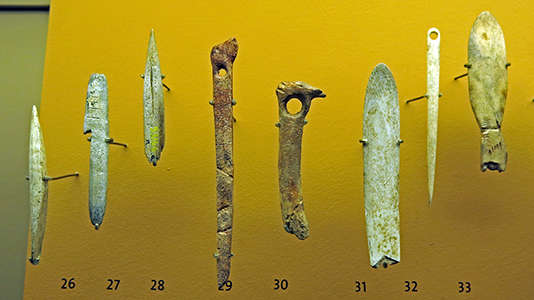
Placard bone and antler industry
Couches B et E: Magdalénien:
26: Spear tip on a simple bevel, original
27: Hook of a propulseur or spear thrower, original
28: Spear tip of the Lussac-Angles type, original. These are from the Middle Magdalenian, and are rather short and wide to lanceolate, on a single bevel, sharp at the distal end, with a long unstriated bevel, always on the upper side, and a groove frequently on the underside.
(text adapted from http://www.catalogue-roc-aux-sorciers.fr/html/12/collection/2_6_3_2.html)
29: Carved bâton showing a human head, facsimile
30: Carved bâton percé showing a young deer, facsimile
31: Lissoir, or polisher, usually made of a deer rib, used to work hides for clothing and other useful products. Eventually the tip would break off on one end, in a very typical manner, as in this case. Original.
32: Eyed needle. Original.
33: Spatula in the form of a fish. Facsimile.
Photo: Don Hitchcock 2014
Source: Display, Musée d'Archeologie Nationale et Domaine, St-Germain-en-Laye
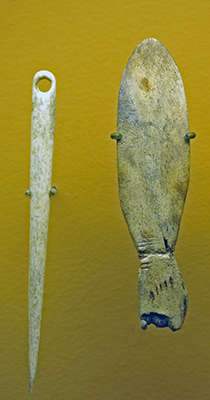
Placard bone and antler industry
Couches B et E: Magdalénien:
32: Eyed needle. Original.
33: Spatula in the form of a fish. Facsimile.
Photo: Don Hitchcock 2014
Source: Display, Musée d'Archeologie Nationale et Domaine, St-Germain-en-Laye
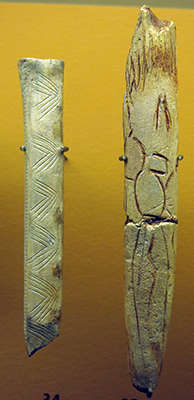
Placard bone and antler industry
Couches B et E: Magdalénien:
34: Bone engraved with chevron motifs. Facsimile.
35: Bevel engraved with a human silhouette. Facsimile.
Photo: Don Hitchcock 2014
Source: Display, Musée d'Archeologie Nationale et Domaine, St-Germain-en-Laye


Placard bone and antler industry
Couches B et E: Magdalénien:
36: Baguette sculpted with a human face. Facsimile.
Photo: Don Hitchcock 2014
Source: Display, Musée d'Archeologie Nationale et Domaine, St-Germain-en-Laye
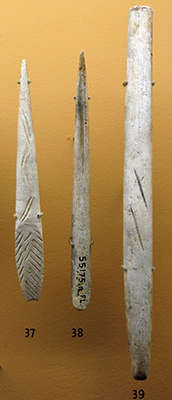
Placard bone and antler industry
Couches B et E: Magdalénien:
37: Spear tip with a simple bevel. Original.
38: Spear tip with a simple bevel. Original. (note that this appears to be a spear tip of the Lussac-Angles type - Don )
39: Engraved ciseau, ('chisel') or lissoir. Original.
Photo: Don Hitchcock 2014
Source: Display, Musée d'Archeologie Nationale et Domaine, St-Germain-en-Laye

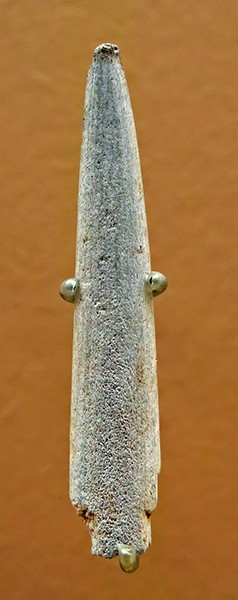
(left): Magdalenian spear point with a simple pointed base, from la grotte du Placard.
Dimensions: length 118 mm, width 13 mm, thickness 8 mm.
Catalog: MAN55021
(right): Magdalenian spear point with a trimmed base, from la grotte du Placard.
Dimensions: length 60 mm, width 11 mm, thickness 7 mm.
Catalog: MAN55072g
Photo: Don Hitchcock 2015
Source: Original, Musée d'Archeologie Nationale et Domaine, St-Germain-en-Laye
Text: https://www.photo.rmn.fr

Magdalenian spear point with a single bevel in reindeer antler from la grotte du Placard.
Dimensions: length 129 mm, width 13 mm, thickness 7 mm.
Catalog: MAN55020a
Photo: Don Hitchcock 2015
Source: Original, Musée d'Archeologie Nationale et Domaine, St-Germain-en-Laye
Text: https://www.photo.rmn.fr


Solutrean bone Poinçon or awl for making holes in leather from la grotte du Placard.
Dimensions: length 73 mm, width 8 mm, thickness 7 mm.
Catalog: MAN54023.3
Solutrean bone Poinçon or awl for making holes in leather from la grotte du Placard.
Dimensions: length 87 mm, width 16 mm, thickness 9 mm.
Catalog: MAN54934L
Photo: Don Hitchcock 2015
Source: Original, Musée d'Archeologie Nationale et Domaine, St-Germain-en-Laye
Text: https://www.photo.rmn.fr
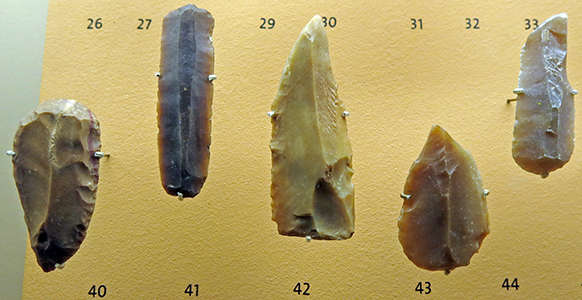
Placard lithic industry
Couches B et E: Magdalénien:
40 and 41: Grattoir. Original.
42: Burin. Original. (note the thumb hollow which has been added to this tool to make it easier to grasp and use. This is a feature of some Placard tools - Don )
43 and 44: Grattoir-burin. Original.
Photo: Don Hitchcock 2014
Source: Display, Musée d'Archeologie Nationale et Domaine, St-Germain-en-Laye
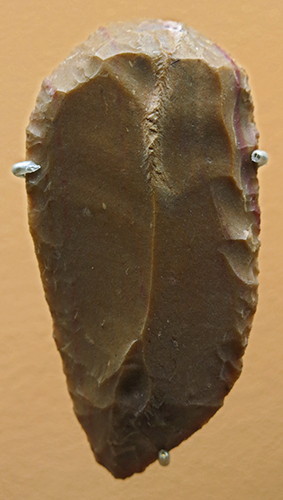
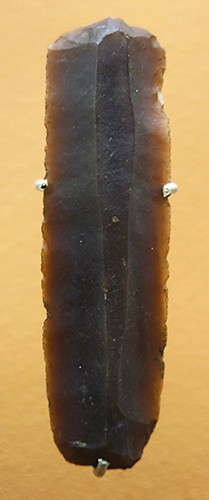
Placard lithic industry
Couches B et E: Magdalénien:
Grattoirs.
Period: Magdalenian
Provenance: Le Placard, layers B and E
Photo: Don Hitchcock 2015
Source: Original, Musée d'Archeologie Nationale et Domaine, St-Germain-en-Laye
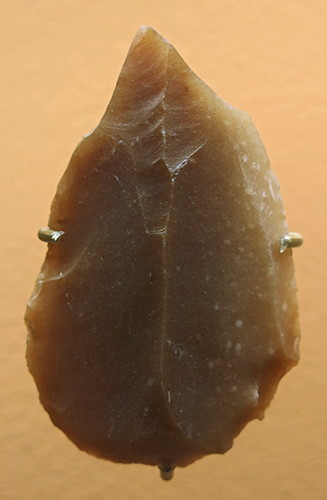
Placard lithic industry
Couches B et E: Magdalénien:
Grattoir-burin.
Period: Magdalenian
Provenance: Le Placard, layers B and E
Photo: Don Hitchcock 2015
Source: Original, Musée d'Archeologie Nationale et Domaine, St-Germain-en-Laye
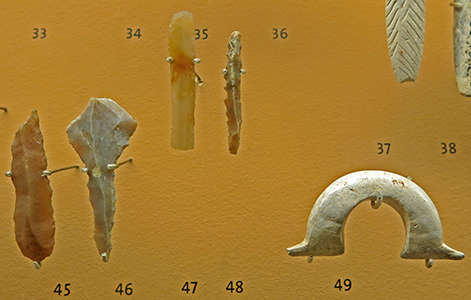
Placard lithic, bone, and antler industry
Couches B et E: Magdalénien:
45: Perçoir. Original.
46: Point de Teyjat. Original. (named after the flint tools found at the Grotte de la Mairie à Teyjat in the north of the Dordogne, notable for its beautiful engravings of Aurochs - Don )
47 and 48: Lamelle à dos, small backed blades. Original.
49: Object in the form of a handle. Original.
Photo: Don Hitchcock 2014
Source: Display, Musée d'Archeologie Nationale et Domaine, St-Germain-en-Laye
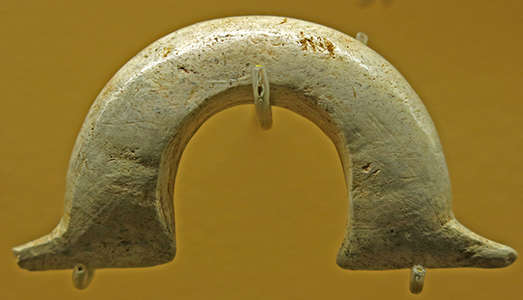
Placard bone and antler industry
Couches B et E: Magdalénien:
Object in the form of a handle. Original. Similar objects have been found near Pech Merle.
These are known as Anneaux Ouverts, or open rings.
( At first I thought that they could indeed have been very useful as a handle, bound by sinew or cord to a basket or hide bucket for ease of carrying, but they are far too small for that purpose, being only circa 4 - 5 cm wide - Don )
Raux et al. (1997) describe similar anneaux ouverts from 'La cave à Endives' or Le Pech del Mas à Cabrerets, close to Pech Merle, see below.
Photo: Don Hitchcock 2014
Source: Display, Musée d'Archeologie Nationale et Domaine, St-Germain-en-Laye
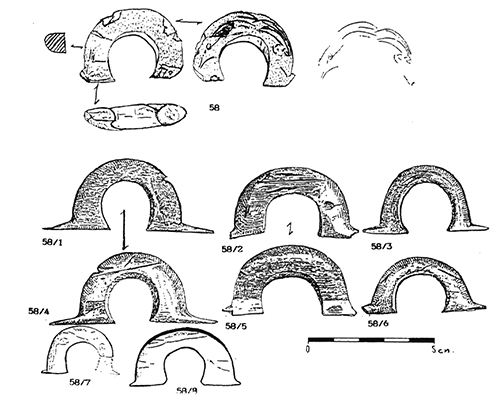
These are described by Raux et al. (1997) as personal ornaments.
Élément de parure, n° 58 : Anneau ouvert collection André David, nos 58/1 - 58/2 Anneaux ouverts, 'Le Placard' (Charente) Couche Magdalénienne III, - d'après H. Breuil (Collection 'De Maret', Musée de Saint-Germain-en-Laye), nos 58/3 - 58/8 : Anneau ouvert 'Le Placard' Couche Magdalénienne supérieure - d'après H. Breuil (Collection 'De Maret', Musée de Saint-Germain-en-Laye).
Drawings by Raux P.
Photo and text: Raux et al. (1997)
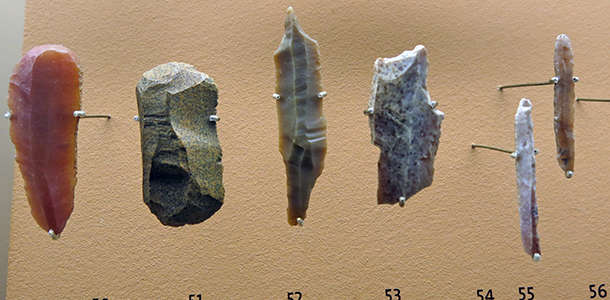
Placard lithic industry
Couches F et G: Solutréen:
50: Grattoir. Original.
51: Grattoir double. (Note the thumb hollow knapped to make the grattoir easier to use in the hand - Don ) Original.
52: Perçoir. Original.
53: Burin. Original.
54: Backed blade. Original.
55: Backed blade. Original.
Photo: Don Hitchcock 2014
Source: Display, Musée d'Archeologie Nationale et Domaine, St-Germain-en-Laye
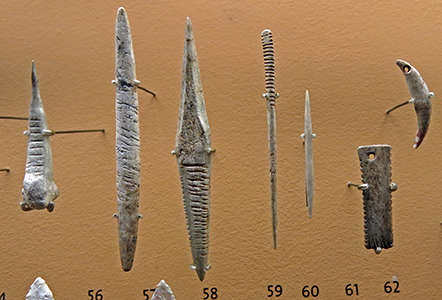
Placard bone and antler industry
Couches F et G: Solutréen:
56: Poinçon (awl) engraved. Original.
57: Spearpoint with simple (not bevelled or split) base. Original.
58: Spearpoint (?) engraved. Original.
59: Épingle (straight pin) engraved. Original.
60: Double point. Original.
61 and 62: Pendant. Original.
Photo: Don Hitchcock 2014
Source: Display, Musée d'Archeologie Nationale et Domaine, St-Germain-en-Laye
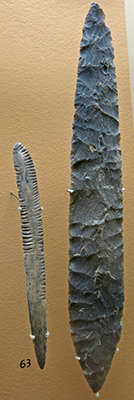
Placard bone and lithic industry
Couches F et G: Solutréen:
63: Engraved bone. Facsimile.
64: Feuille de laurier, laurel leaf blade typical of the Solutrean.
They may have been purely status objects, as similar large blades were for Australian Aborigines. Original.
Photo: Don Hitchcock 2014
Source: Display, Musée d'Archeologie Nationale et Domaine, St-Germain-en-Laye
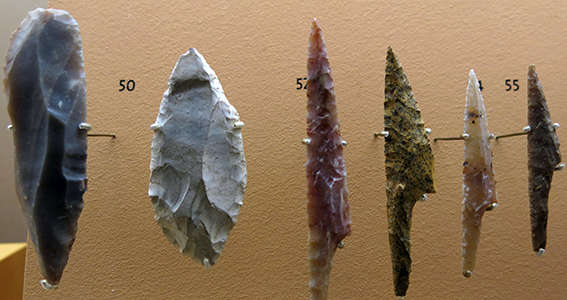
Placard lithic industry
Couches F et G: Solutréen:
65 and 66: Pointe à face plane, points worked on only one side. Original.
67 to 70: Pointe à cran - shouldered points. Original.
Photo: Don Hitchcock 2014
Source: Display, Musée d'Archeologie Nationale et Domaine, St-Germain-en-Laye
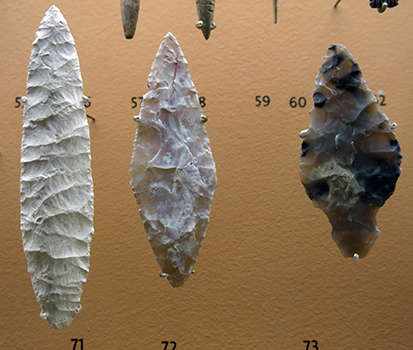
Placard lithic industry
Couches F et G: Solutréen:
71 and 72: Feuille de laurier, laurel leaf blades. Original.
73: Pointe à pédoncule, stalked point. Original.
Photo: Don Hitchcock 2014
Source: Display, Musée d'Archeologie Nationale et Domaine, St-Germain-en-Laye
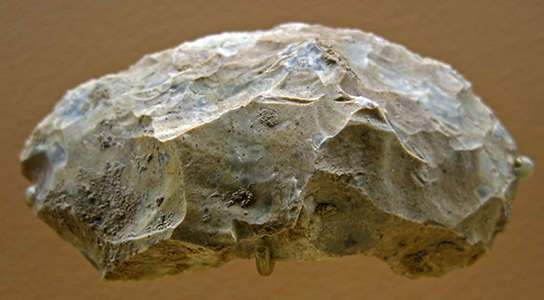
Placard lithic industry
Couches F et G: Solutréen:
74: Racloir, scraper. Original.
Photo: Don Hitchcock 2014
Source: Display, Musée d'Archeologie Nationale et Domaine, St-Germain-en-Laye
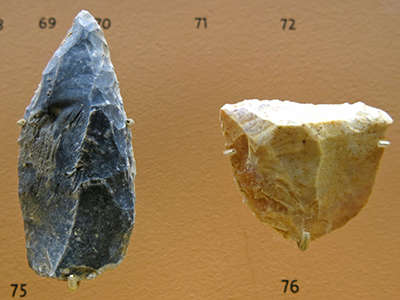
Placard lithic industry
Couches F et G: Solutréen:
75 and 76: Racloir double, double scrapers. Original.
Photo: Don Hitchcock 2014
Source: Display, Musée d'Archeologie Nationale et Domaine, St-Germain-en-Laye
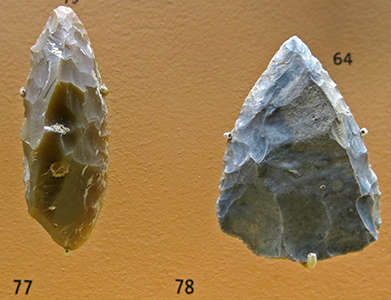
Placard lithic industry
Couches F et G: Solutréen:
77: Racloir double, double scraper. Original.
78: Mousterian point. Original.
Photo: Don Hitchcock 2014
Source: Display, Musée d'Archeologie Nationale et Domaine, St-Germain-en-Laye
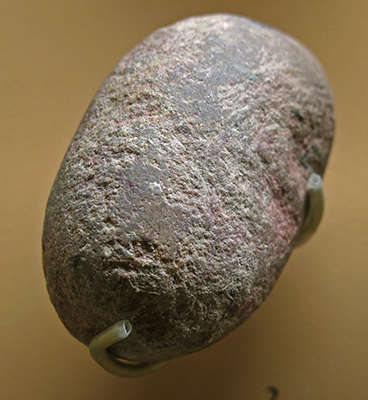
Placard lithic industry
Percuteur from Placard, a hammer stone for making flint tools, bearing evidence of its use.
Original
Photo: Don Hitchcock 2014
Source: Display, Musée d'Archeologie Nationale et Domaine, St-Germain-en-Laye
Reproduction of the engravings of the principal decorated panel at Placard, the photo montage below providing a more detailed view.
The engravings are of two categories: figurative (representations of animals) and abstract (signs).
They are the result of the campaigns of excavations directed by Jean Clottes with the collaboration of Louis Duport and Valérue Feruglio, from 1990 to 1993 and in 1995.
Drawing: V. Feruglio.
Source: Clottes et al. (2010)
Grotte du Placard engravings as physical objects
These objects would appear to have been created by scanning the very small engravings, then enlarging and printing them out on a digital 3D printer. This technique is set to revolutionise the display of the world's archaeological treasures by making high quality reproductions available to all at a modest cost, with the file sent to the recipient, who then uses their own 3D printer to print them out. However the result is still the colour of the plastic used, often white or clear, so the resulting model still has to be realistically coloured by hand.
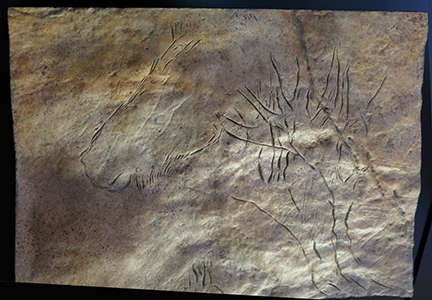
Engraving showing a horse and what may be an antler.
Photo: Don Hitchcock 2104
Source: Display, Grotte du Placard
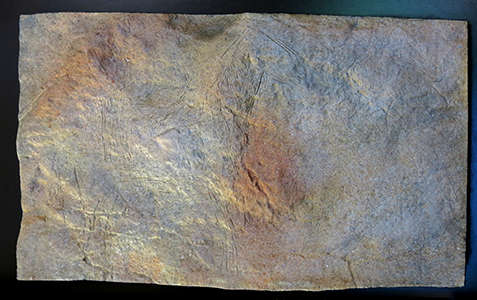
Engraving showing a horse and a placard sign. The technique involves multiple strokes to build up the image.
Photo: Don Hitchcock 2104
Source: Display, Grotte du Placard
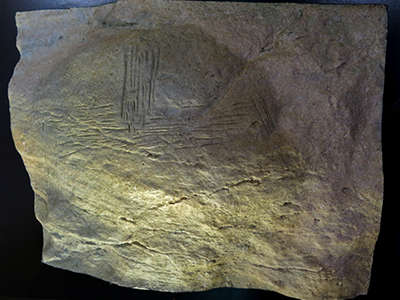
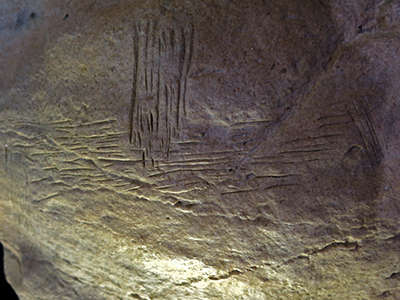
Placard sign
Photo: Don Hitchcock 2104
Source: Display, Grotte du Placard
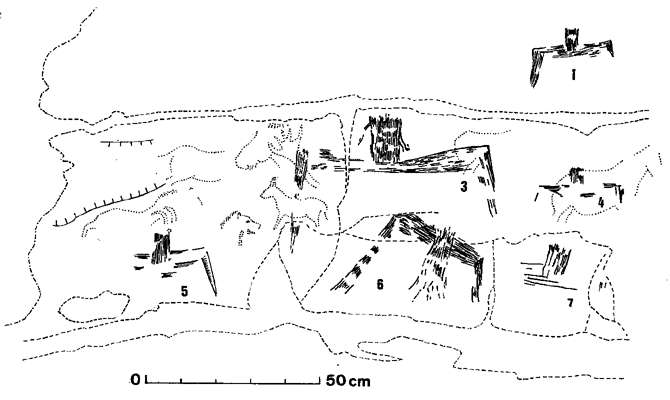
Grotte du Placard,"signes de type Placard" (d’après relevé V. Feruglio).
Photo: Petrognani et Robert (2009)
Aviform signs
So designated because of their shape evoking that of a bird, at least as we usually depict them schematically, they are also called "Signs of the Placard type".
It is in the grotte du Placard in Charente where we find the largest number (eleven, all engraved), and it is in this site that an indirect relative dating was possible. Indeed, the wall where the signs are has been partially covered by the Solutrean levels.
This was confirmed in absolute terms by radiocarbon dating of a bone stuck in the rock above the engravings, which provided a date of 19 970 BP (Clottes et al. 1990).
This date is the youngest the engravings could be, but they may belong to an even earlier phase.
The signs are mostly made up of four elements, whose order of plotting is as follows: the vertical rectangle, the horizontal band and the 2 underlying appendages.(Clottes et al. 1990)
The model construction is found in identical form in the caves of Pech Merle, Quercy (three signs), and especially at Cougnac, with eight examples, of which only one is engraved, the latter however without reproducing the entire pattern, since only the rectangular vertical protrusion and one side of the horizontal band are represented.
If we can not precisely date any signs from Cougnac and Pech Merle, the elements of chronology at our disposal in these two caves (radiocarbon dates for the Gravettian to the Magdalenian at Cougnac, equivalent to the historical allocations at Pech Merle) this does not contradict the data of Placard, and allow us to consider a time allocation of around the Solutrean, or an earlier period. We can consider that we are facing one of the oldest examples of the dissemination of abstract symbolism in a regional area.
Text: Translated by Don Hitchock from Petrognani et Robert (2009)
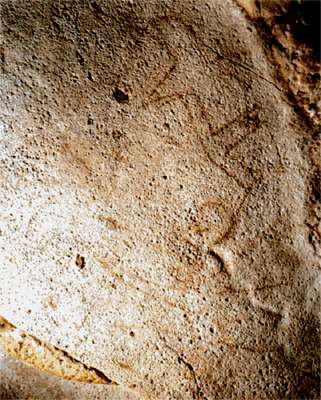
"Placard Sign" and speared man in the cave of Pech Merle.
Photo: Bahn and Vertut (1997)
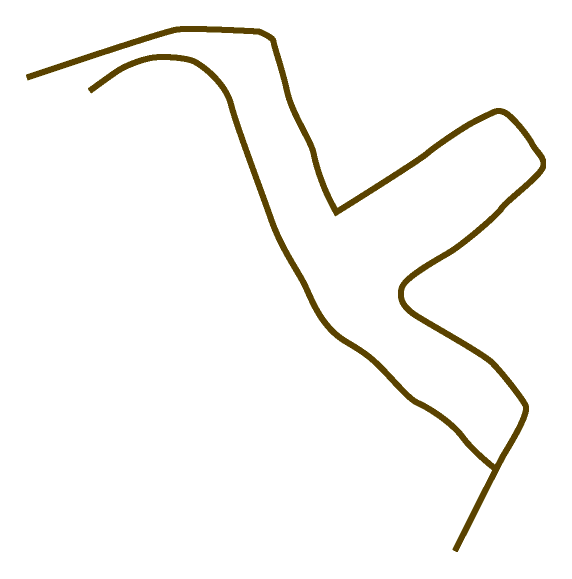
Placard Sign from Pech Merle redrawn. Note the bird like shape of this sign. These signs occur in eleven painted forms at Cougnac, three times at Pech Merle, and as seven engraved forms at Grotte du Placard. They are possibly Solutrean - Bahn and Vertut (1997)
Photo: Redrawn by Don Hitchcock after Bahn and Vertut (1997)
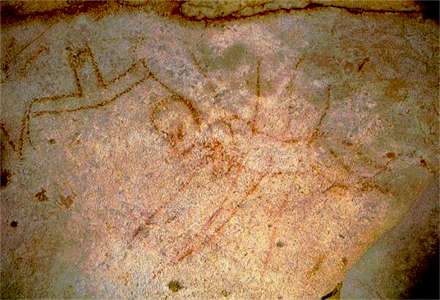
Type Placard sign and a man wounded by several spears, in red ochre. Height 75 cm, from Grotte du Pech-Merle, Lot. Probably from the Solutrean.
Photo: Michel Lorblanchet, via ma.prehistoire.free.fr/signe_au_pm.htm
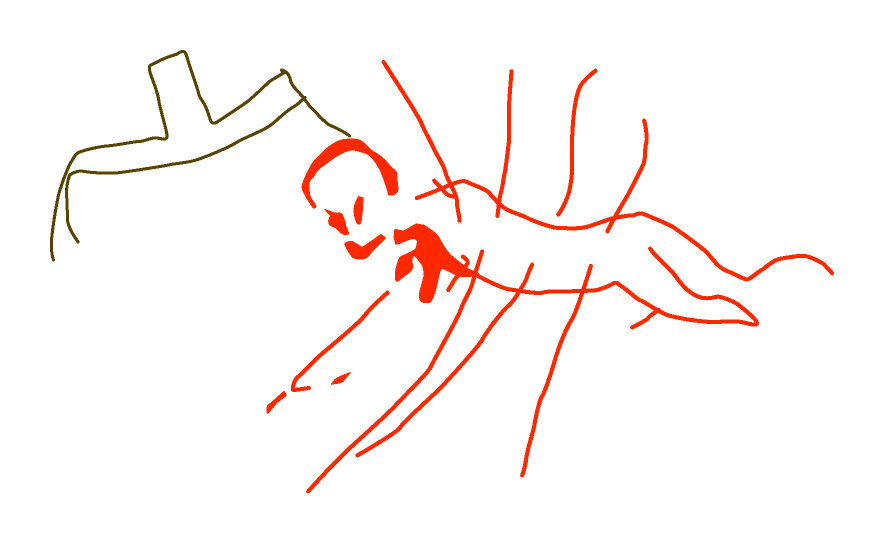
Type Placard sign and a man wounded by several spears, in red ochre. Height 75 cm, from Grotte du Pech-Merle, Lot. Probably from the Solutrean.
Photo: Redrawn by Don Hitchcock after Michel Lorblanchet, via http://ma.prehistoire.free.fr/signe_au_pm.htm
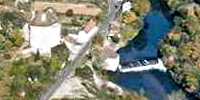
Pech Merle is one of the few prehistoric cave painting sites in France which remain open to the general public. Extending for more than a mile from the entrance are caverns the walls of which are painted with dramatic murals dating from the Gravettian culture (some 25 000 years BP) Some of the paintings and engravings, however, could date from the later Magdalenian era (16 000 years BP). The walls of seven of the chambers at Pech Merle have fresh, lifelike images of a woolly mammoth, spotted horses, bovids, reindeer, handprints, and some human figures. Footprints of children, preserved in what was once clay, have been found more than a kilometre underground.
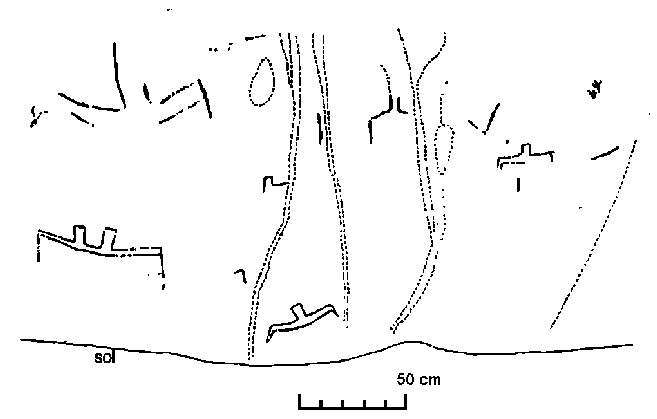
Placard type signs are known from not just Grotte de Placard, but also from Grotte de Cougnac, Pech Merle and Cosquer. These signs are from Grotte de Cougnac.
The signs are not associated with other figures.
The wounded man theme is rare in Paleolithic art, but occurs at both Cougnac and Pech-Merle, as well as Lascaux.
In both Pech Merle and Cougnac, the Placard signs are localised to a single panel, in areas deep within the cave, away from areas which are easily accessible. Neither Pech Merle nor Cougnac were inhabited, they were strictly for ceremonial purposes.
Photo: http://ma.prehistoire.free.fr/cougnac_plac.htm
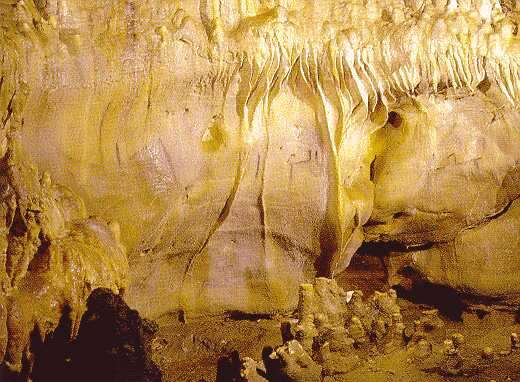
Placard type signs can be seen on this wall from Cougnac. Similar signs are known from Pech Merle, less than fifty kilometres away, and from Cosquer, many hundreds of kilometres away.
Photo: http://ma.prehistoire.free.fr/cougnac_plac.htm
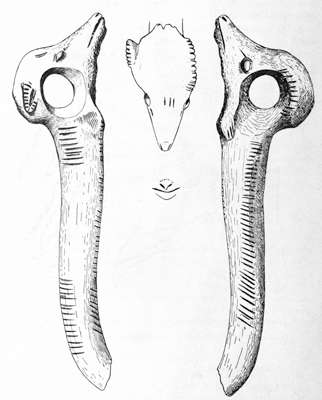
Head of a fox carved on a bâton de commandement from Placard, Charente.
(note that this is now believed to be an ibex, see below - Don )
Photo: Drawing by M. l'Abbé Breuil: from Capitan et al. (1910)
Source: Macalister (1921) (Public Domain)
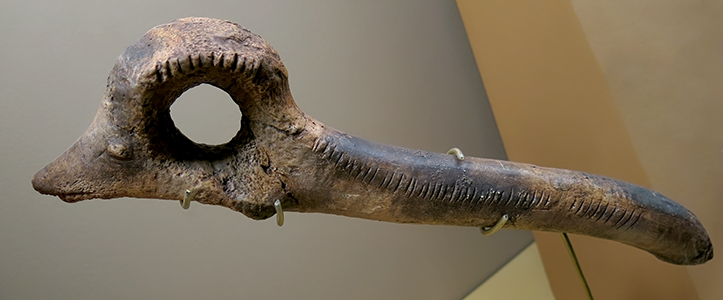
Placard antler industry
Bâton percé sculpted in the shape of an ibex.
Facsimile
Photo: Don Hitchcock 2015
Source: Display, Musée d'Archeologie Nationale et Domaine, St-Germain-en-Laye
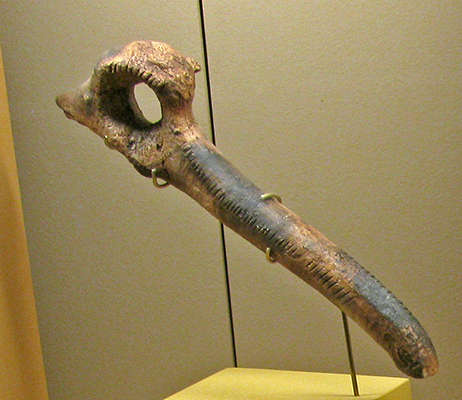
Placard antler industry
Another view of the bâton percé sculpted in the shape of an ibex.
Facsimile
Photo: Don Hitchcock 2014
Source: Display, Musée d'Archeologie Nationale et Domaine, St-Germain-en-Laye
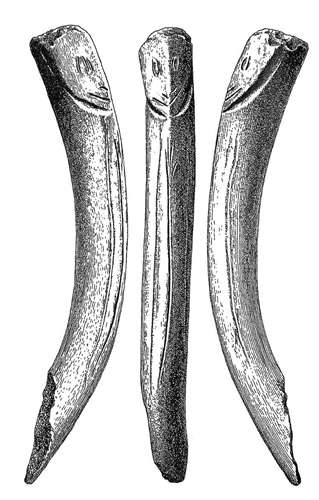
Engraved bone from Placard.
Photo: Dujardin et al. (2005), after Laurent (1963)
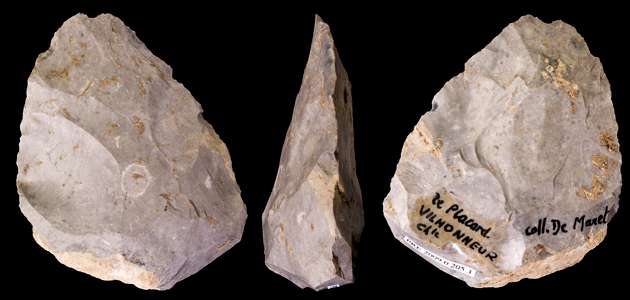
Mousterian flint biface from Grotte du Placard, different views of the same specimen.
Age between 300 000 - 30 000 BP (Middle Palaeolithic - Mousterian)
Dimensions 62 × 50 × 23 mm - 59.7g
Current location: Muséum de Toulouse, Accession number: MHNT.PRE.2009.0.205.3
Found at: Le Placard cave, Vilhonneur Charente, France – Former collection of De Maret
Photo: Didier Descouens, 24 December 2010
Permission: I, the copyright holder of this work, hereby publish it under the following license:
This file is licensed under the Creative Commons Attribution-Share Alike 3.0 Unported license.
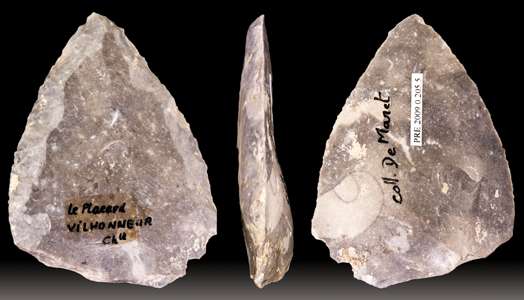
Retouched Levallois flake from Grotte du Placard, different views of the same specimen.
Age between 300 000 - 30 000 BP (Middle Palaeolithic - Mousterian)
Dimensions 64 × 49 × 12 mm - 33.9g
Current location: Muséum de Toulouse, Accession number: MHNT.PRE.2009.0.205.5
Found at: Le Placard cave, Vilhonneur Charente, France – Former collection of De Maret
Photo: Didier Descouens, 24 December 2010
Permission: I, the copyright holder of this work, hereby publish it under the following license:
This file is licensed under the Creative Commons Attribution-Share Alike 3.0 Unported license.
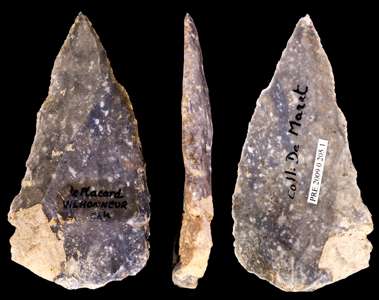
Levallois point from Grotte du Placard, different views of the same specimen.
Age between 300 000 - 30 000 BP (Middle Palaeolithic - Mousterian)
Dimensions 72 × 37 × 8 mm - 18.6 g
Current location: Muséum de Toulouse, Accession number: MHNT.PRE.2009.0.205.1
Found at: Le Placard cave, Vilhonneur Charente, France – Former collection of De Maret
Photo: Didier Descouens, 24 December 2010
Permission: I, the copyright holder of this work, hereby publish it under the following license:
This file is licensed under the Creative Commons Attribution-Share Alike 3.0 Unported license.
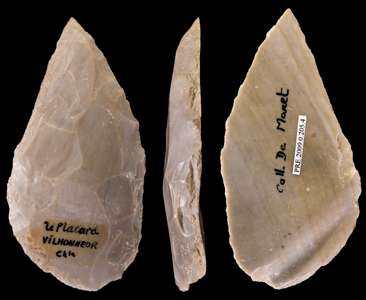
Mousterian flint point from Grotte du Placard, different views of the same specimen.
Age between 300 000 - 30 000 BP (Middle Palaeolithic - Mousterian)
Dimensions 81 × 43 × 12 mm - 36.5 g
Current location: Muséum de Toulouse, Accession number: MHNT.PRE.2009.0.205.4
Found at: Le Placard cave, Vilhonneur Charente, France – Former collection of De Maret
Photo: Didier Descouens, 24 December 2010
Permission: I, the copyright holder of this work, hereby publish it under the following license:
This file is licensed under the Creative Commons Attribution-Share Alike 3.0 Unported license.
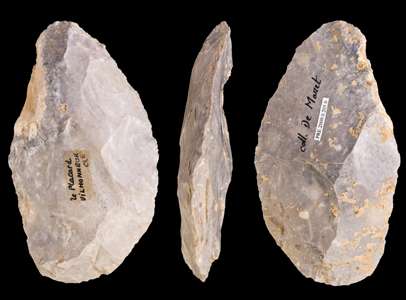
Racloir from Grotte du Placard, different views of the same specimen.
Flint scraper / knife
Age between 300 000 - 30 000 BP (Middle Palaeolithic - Mousterian)
Dimensions 105 × 60 × 21 mm - 110.3 g
Current location: Muséum de Toulouse, Accession number: MHNT.PRE.2009.0.205.6
Found at: Le Placard cave, Vilhonneur Charente, France – Former collection of De Maret
Photo: Didier Descouens, 24 December 2010
Permission: I, the copyright holder of this work, hereby publish it under the following license:
This file is licensed under the Creative Commons Attribution-Share Alike 3.0 Unported license.
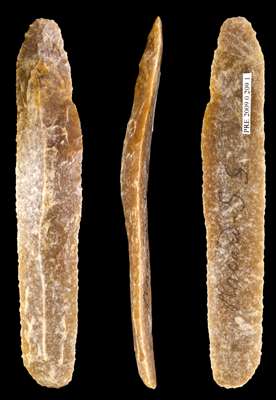
Chert blade from Grotte du Placard, different views of the same specimen.
Age between 30 000 - 10 000 BP
Dimensions 104 × 19 × 12 mm - 15.1g
Current location: Muséum de Toulouse, Accession number: MHNT.PRE.2009.0.209.1
Found at: Le Placard cave, Vilhonneur Charente, France – Former collection of De Maret
Photo: Didier Descouens, 01 January 2010
Permission: I, the copyright holder of this work, hereby publish it under the following license:
This file is licensed under the Creative Commons Attribution-Share Alike 3.0 Unported license.
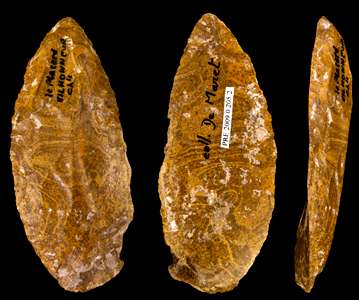
Chert blade from Grotte du Placard, different views of the same specimen.
(Note the interesting patterns in this banded chert, and the dark crystalline inclusions seen at full magnification - Don)
Age between 300 000 - 30 000 BP
Dimensions 79 × 36 × 12 mm - 30.4g
Current location: Muséum de Toulouse, Accession number: MHNT.PRE.2009.0.205.2
Found at: Le Placard cave, Vilhonneur Charente, France – Former collection of De Maret
Photo: Didier Descouens, 07 November 2010
Permission: I, the copyright holder of this work, hereby publish it under the following license:
This file is licensed under the Creative Commons Attribution-Share Alike 3.0 Unported license.
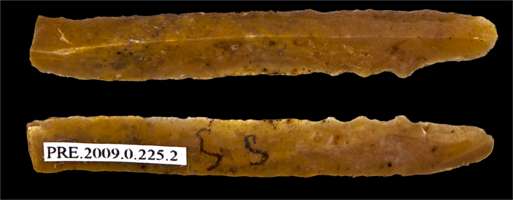
Truncated bladelet from Grotte du Placard, different views of the same specimen.
(Note the weight of this piece - less than one gram, and the little denticulations on one end of the bladelet. This piece is almost certainly towards the younger end of the range - Don)
Age between 35 000 - 10 000 BP
Dimensions 40 × 7 × 4 mm - 0.7g
Current location: Muséum de Toulouse, Accession number: MHNT.PRE.2009.0.225.2
Found at: Le Placard cave, Vilhonneur Charente, France – Former collection of De Maret
Photo: Didier Descouens, 01 January 2011
Permission: I, the copyright holder of this work, hereby publish it under the following license:
This file is licensed under the Creative Commons Attribution-Share Alike 3.0 Unported license.
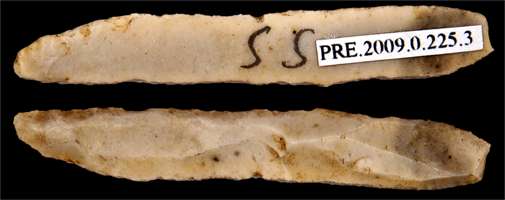
Backed edge bladelet from Grotte du Placard, different views of the same specimen.
Age between 35 000 - 10 000 BP
Dimensions 40 × 7 × 4 mm - 0.7g
(? these are the same dimensions and weight as the piece above - one of them must be in error. Note the different relative sizes of the standard label, and the relative width versus length - Don)
Current location: Muséum de Toulouse, Accession number: MHNT.PRE.2009.0.225.3
Found at: Le Placard cave, Vilhonneur Charente, France – Former collection of De Maret
Photo: Didier Descouens, 01 January 2011
Permission: I, the copyright holder of this work, hereby publish it under the following license:
This file is licensed under the Creative Commons Attribution-Share Alike 3.0 Unported license.
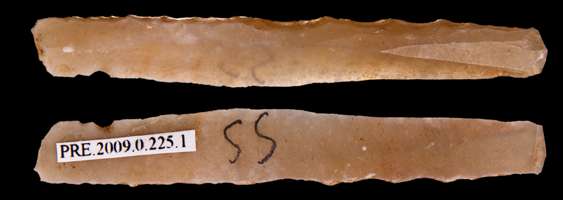
Microlame, a backed edge bladelet from Grotte du Placard, different views of the same specimen.
(Note that this specimen, made of flint, is so thin that we can see the "SS" mark through the thickness of the piece in the top image - Don)
Age between 35 000 - 10 000 BP
Dimensions 52 × 8 × 4 mm - 1.5g
Current location: Muséum de Toulouse, Accession number: MHNT.PRE.2009.0.225.1
Found at: Le Placard cave, Vilhonneur Charente, France – Former collection of De Maret
Photo: Didier Descouens, 08 January 2011
Permission: I, the copyright holder of this work, hereby publish it under the following license:
This file is licensed under the Creative Commons Attribution-Share Alike 3.0 Unported license.
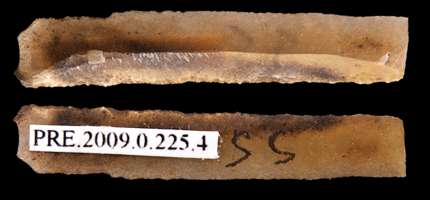
Truncated flint bladelet from Grotte du Placard, different views of the same specimen.
Age between 35 000 - 10 000 BP
Dimensions 29 × 6 × 3 mm - 0.3g
Current location: Muséum de Toulouse, Accession number: MHNT.PRE.2009.0.225.4
Found at: Le Placard cave, Vilhonneur Charente, France – Former collection of De Maret
Photo: Didier Descouens, 08 January 2011
Permission: I, the copyright holder of this work, hereby publish it under the following license:
This file is licensed under the Creative Commons Attribution-Share Alike 3.0 Unported license.
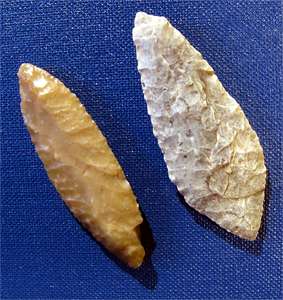
Solutrian points from the Placard cave (middle or upper Solutrean; about 20 000 BP). This artefact was made by fine pressure flaking on (heat tempered) excellent flint.
It seems that the first excavations at the Placard cave (near Vilhonneur, Charente) took place in 1853. For the next hundred years the cave was the target of surveys that were performed without serious archaeological methods and without scientific accounts.
The official and somewhat theoretical stratigraphy was published by A. de Mortillet in 1906. He described a "Robenhausien" on the top and below, three Magdalenian levels, two Solutrean levels and, at the base the Mousterian. On his stratigraphy, each level was isolated by a sterile layer formed by the debris, which fell from the cave ceiling.
Renewed serious excavations during the last 30 years were able to trace intact Paleolithic deposits. The most interesting findings in the Solutrean layers were the detection of a dozen enigmatic signs called "aviforms" (in the shape of birds wings). It is suggested that such signs, which are found in the Charente (i.e. Placard) and in the Departement Lot (Pech Merle, Cougnac) are indicative of a cultural group or even a group with a common ancestor, who visited these caves during the last glacial maximum, separated by more than 150 km from each other.
Photo and text: by Katzman, whose very interesting blog on various tools may be found at: Aggsbach's Paleolithic Blog
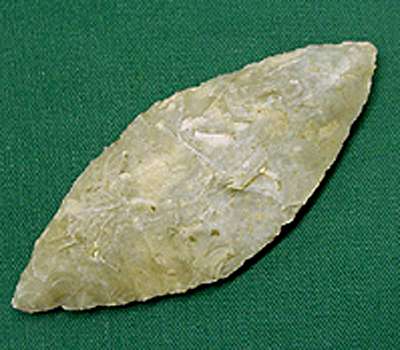
Willow Leaf Point from Le Placard
Upper Solutrean, ca. 16 000 BP
LMA 4.6.148
This is a fine example of the classic Solutrean "Willow Leaf" point.
Photo and text: http://www.beloit.edu/logan_online/exhibitions/virtual_exhibitions/before_history/europe/le_placard.php
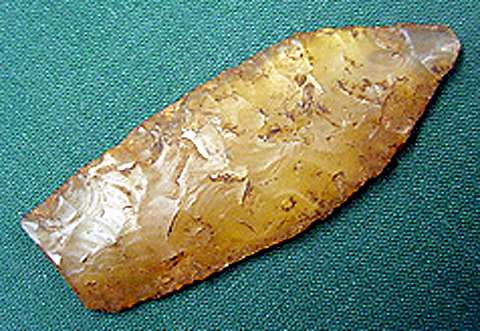
Laurel Leaf Point from Le Placard
Upper Solutrean, ca. 16 000 BP
LMA 4.6.147
This point was nearly complete before the base apparently broke.
Photo and text: http://www.beloit.edu/logan_online/exhibitions/virtual_exhibitions/before_history/europe/le_placard.php
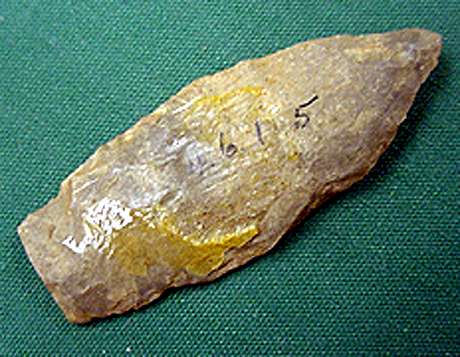
Laurel Leaf Point from Le Placard
Upper Solutrean, ca. 16 000 BP
LMA 4.6.145
Another unfinished point, broken at the base.
Photo and text: http://www.beloit.edu/logan_online/exhibitions/virtual_exhibitions/before_history/europe/le_placard.php
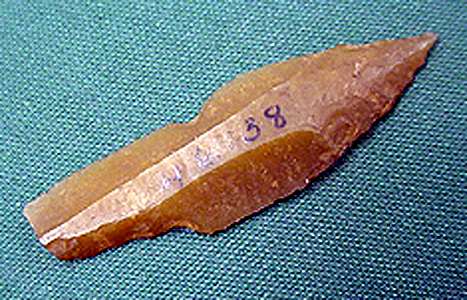
Pointe à Crâne from Le Placard
Shouldered point.
Upper Solutrean, ca. 16 000 BP
LMA 4.6.138
Photo and text: http://www.beloit.edu/logan_online/exhibitions/virtual_exhibitions/before_history/europe/le_placard.php

Spear point, grotte du Placard, Vilhonneur, Charente
Photo and text: Baumann (2008)
Un propulseur inédit de la Grotte du Placard
In 1993, A Debénath and J. Tournepiche included a previously unpublished propulseur in the pamphlet published by the museum in Angouleme on the occasion of the opening of a hall of archeology. The object was not described, there is just a note: "Hook of a propulseur made of reindeer antler from the Grotte du Placard."
I want to thank the curator at Musée d'Angoulême, who allowed me to study and publish the object.
This propulseur or atl-atl comes from the collection of Dr. L'homme, bequeathed to the Musée d'Angoulême in 1932. Prehistoric objects in this collection come almost entirely from the research made by the donor's uncle, Jean Fermond, in the second half of the 19th century.
He was also the discoverer of the Grotte du Placard, a little before 1860, and made the first excavation there, very basic, lacking any stratigraphic observation.
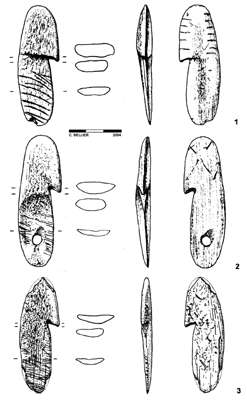
Fig. 1
Description:
Propulseur hook (fig 1:1) almost complete (there is a small chip to the proximal portion of the edge of the half-lap section), gray-beige, oval profile and a basic simple half-lap for attaching to the propulseur. It was made using a strip of the cortex of reindeer antlers and shows signs of spongiosa (spongy part of the bone) on the left side face. On this front, the half-lap joint intended for fitting occupies more than half the length of the object, and is deeply grooved (presumably to provide a secure attachment to the spear - Don). The distal portion of the right lateral side, beyond the hook, shows five small incisions and, parallel the upper side, seven on the lower side, as may be seen on the diagram.
Dimensions 69 x 9 x 23 mm
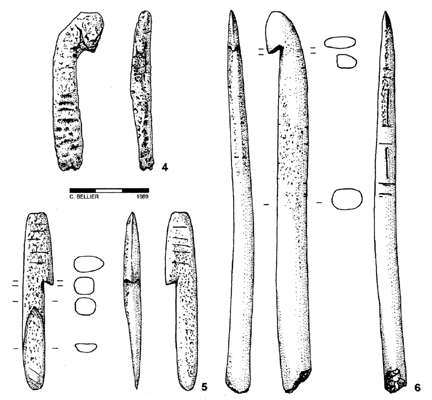
Fig. 2
Fig 2-4: Propulseur from la grotte d'El Castillo (Santander), Museo Arqueologico Nacional, Madrid
Fig 2-5 and 2-6: Propulseurs from la grotte du Placard (Charente), Musée des Antiquités nationales, Saint Germain-en-Laye.
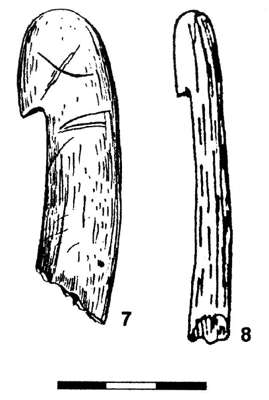
Propulseurs from la Grotte du Placard.
7 after Chauvet (1910), 8 after Breuil (1937)
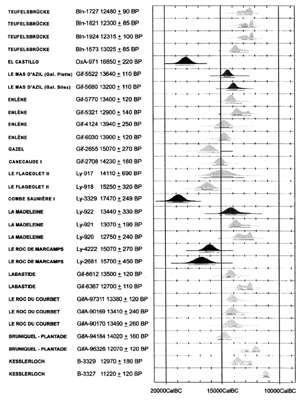
C14 ages for propulseurs. In black, the propulseurs of type 2, group 1. In grey, propulseurs of type 2, group 2
Type 2: male type, hook, not ornamented or only engraved with simple designs, tongue or strap shaped.
Group 1: generally very short pieces, using a simple half-lap, always located on the left side face, with traces of spongiosa. The section affects a subtriangular hook shape with the two sides slightly convex, which is not the case for other types of male Palaeolithic propulseurs, where the hook is tapered. The objects of this group are never associated with other types of propulseurs.
Group 2: the propulseurs are generally much more elongated and often have a perforated base.
Deux curieuses pièces de la grotte du Placard
Maret (1879) has found eight levels archaeological levels perfectly separated by barren beds, formed of fragments of limestone fallen from the ceiling.
He categorised these as:
1 - A Mousterian layer.
2 and 3 - Two Solutrean layers.
4, 5, 6 and 7 - Four Magdalenian layers.
8 - A Robenhausienne layer.
The upper layers have been partially disrupted by previous research, such that the industry of each of Magdalenian levels could not be completely isolated. It is, however, for the most part, divided into: Lower Magdalenian, comprising the product of layers 4 and 5, and Magdalenian, including that of layers 6 and 7. A thick bed of limestone scree formed a clear separation between these two divisions. These provided many artefacts of stone and bone industries, including specimens of "bâtons de commandement" made from reindeer antlers.

To this category of objects I will add some examples which are quite different.
Their main interest lies in the representations of human genitalia which they carry. These representations are partly carved and partly engraved. The first piece is a kind of thick blade with rounded tip and slightly curved. The opposite end, which expands and thickens, is broken, it has been pierced by a hole, but only a small portion of it is visible.
On one side stands a figure in relief, in which it is difficult to see anything other than a penis, and probably a human penis, although somewhat thin. The glans, drawn like the rest of the figure by a burin, is slightly raised. It has an oval, elongated form. A broad-furrow dug at the top clearly marks the urethra. The actual body of the penis tapers gradually to the transverse line that separates the glans from the shaft of the penis. As it is now, the piece measures 14 cm long.
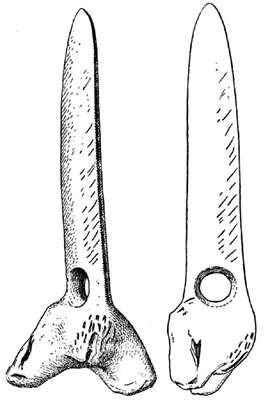
The second example is intact. Its total length is 155 mm. It consists of a straight blade with a sharp tip and edges, 12 cm long and 2 cm wide, ending in a strong bulged fork. The blade is pierced at its base with a fairly regular hole of 15mm diameter. Below this hole has been carved female external genitalia in a manner sufficiently clear to leave no doubt.
A bulge, located in the extension of the sharp blade, is the mount of Venus. The lower part carries a strong vertical cut, in which it is easy to recognize the vulvar slit. The top is surrounded by small incisions, which were obviously intended to represent the hair overlying the pubis. Finally, the two stumps, which form the fork, show the start of the thighs.
All this is rather naive, quite coarse, but exactly reproduced. The two objects mentioned were collected in the lower Magdalenian deposits of Placard, in layers 4 and 5, which contained some attempts at sculpture, but no real engravings.
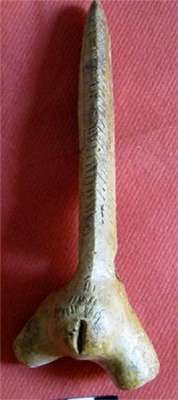
This piece has come to be known as the Venus de la grotte du Placard.
Photo: Giuseppe Novelli, former president of the caving club of Genoa, Italy.
2010.06.13 via http://speleoclubdelaude.blogspot.com/2010/12/les-venus-prehistoriques.html
Source: Facsimile

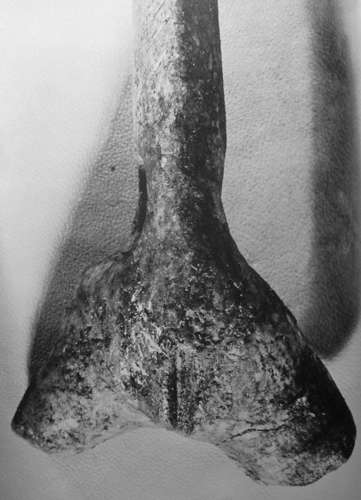
This is one of the very few occasions where the vulva is the main topic of a sculpture, from Placard.
Photo: Marshack (1972)
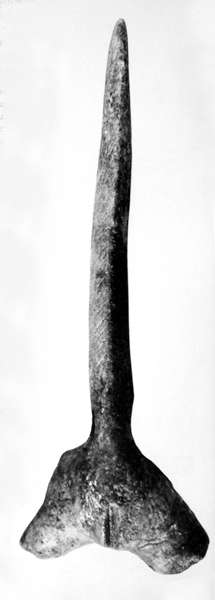
Photo: Marshack (1972)
Source: Original
Os incisé provenant de la grotte du Placard (Charente)
La grotte du Placard is located at a hamlet called Rochebertier in the territory of the commune of Vilhonneur (Charente). It is carved into a strip of Middle Jurassic limestones bordering the Tardoire. The cave consists of a room which is approximately trapezoidal in shape, 17 m long, with an average width of 9 m.
At the end of this room, there is a corridor with a width of 160 cm and oriented towards the north. After 8 m it is blocked by a large boulder. Beyond this a fairly tortuous route has been discovered over a length of 27 m. The site is well known from ancient times and it seems that the first excavations took place around 1853.
It revealed a very rich suite of objects, and during the whole of the second half of the nineteenth century was the subject of intensive searches, especially by its owner, A. Maret. Unfortunately, these works were executed without sufficient method and especially without valid records.
The most complete trench or cross section that we have was published by A. Mortillet in 1906, on the basis of information from from A. Maret. It is too theoretical to be useful.
Finally the deposit, which was without doubt one of the richest in Western Europe, was not subject to any protection and suffered numerous digs that fed many museums and private collections. In 1958, the Laboratory of Paleontology, Faculty of Sciences of Paris, led by Prof. Piveteau decided to try to locate and study the levels still in place. Soon it became clear that the Upper Paleolithic no longer existed in the main salle.
The only remaining deposits in the main room were thin strips at the edges of the salle, too poor to provide useful results. In contrast, in 1960, while cleaning the inside of the cave, I had the opportunity to unblock the entrance to the Northern Corridor obscured by rubble and open it up over a length of 8 m to a stone block forming a plug. I was able to establish that this had been excavated with the exception of a very hard breccia in a hole suspended 40 cm from the roof.
Previously, this deposit spanned almost the entire extent of the room but gradually decreased in depth towards the entrance where it would not be more than 10 cm thick, if you look at the residue still attached the walls. It was excavated during the campaigns of 1961-1962 and contained an industry that can be dated to the Magdalenian III b-IV a.
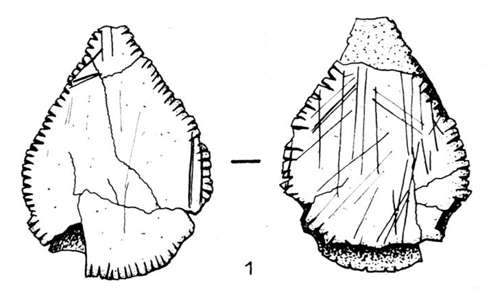
Amongst the items collected, the one shown here seemed to us remarkable enough to report: a pear-shaped carved bone plate from the shoulder region, made from the scapula of a large animal. It is an extremely fragile object, and also the ends and some fragments of the bone are missing. Its current length is 50 mm and its maximum width is 36 mm.
Its edges are lightly serrated by deep short incisions (averaging 2 mm in length) executed on both sides. They have a direction radiating from the center of the object. One side is finely striated with light strokes. The other has some very deep marginal incisions. This is an extremely rare object, and whose interpretation raises many problems.
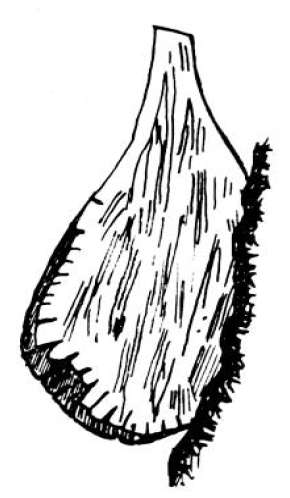
To our knowledge, the only similar piece was discovered in 1927 in the same cave by Denis (1932). His drawing, shown here, although unsatisfactory, allows a comparison. In addition, it was found in a Magdalenian breccia which seems to be the same as ours.
Denis (1932) describes it as a very thin, very fragile bone. It appears (from the drawing that accompanies the article, shown here) that it had not been completely freed from its breccia matrix. Denis noted, however, its dimensions (height of 47 mm, maximum width 30 mm). They coincide almost exactly with those found for our object.
Denis noted that this piece carried on both sides a decoration of straight lines, with lengths from 2 to 3 mm, deep, evenly spaced, and ending with a short stem 4 mm wide.
Based on the presence of this small stalk, and the fact that the piece had a slight concavity in its central section, Denis thought that it might be a decorated spatula or spoon. This assumption seems unsatisfactory.
On the one hand, the delicacy and fragility of the piece prohibit its use as a tool, and its stalk is too small for easy handling. On the other hand, the central concavity observed by Denis is probably not the result of wear but from the infiltration of water charged with lime that has gone little by little between the faces and opened the bone edges. This is at least is the observation that could be made on our copy.
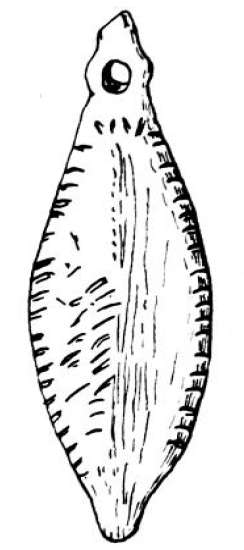

Another somewhat similar piece, judging by the decor, (Cau-Durban 1885) was found at Marsoûlas (Haute-Garonne) by l'abbé Cau-Durban at a middle Magdalenian level. It is a bone plate, oblong, bearing marginal incisions rather reminiscent of those observed on the pieces from Placard. However, it has a perforated stem. The Comte de Saint-Périer (Saint-Périer, 1928) mentions a somewhat similar piece found in la grotte des Harpons à Lespugue (Haute-Garonne) and interprets it as a lure for fishing, analagous to the "spoons" similar to our modern ones as shown in the example at right.
Photo (right): modern spoon fishing lure. Wikimedia, GNU Free Documentation License
Breuil et Saint-Périer (1927) mention the Marsoûlas piece in their work on representations of fish, reptiles and amphibians in Quaternary quaternary. They see a schematic representation of Pleuronectidae (flatfish family) frequenting the seacoast where Soles, the group of fish to which they belong, are found. The marginal incisions would indicate fins, the peduncle the tail, and the striations on the one face the rough skin of the back of these fish.
(The Pleuronectidae are a family of fish called "righteye flounders" because most species lie on the sea bottom on their left side, with both eyes on the right side - Don)
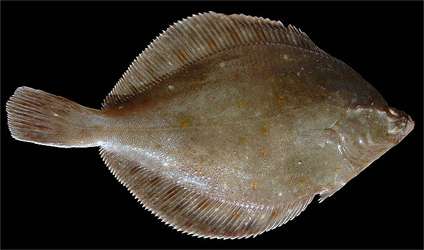
Pleuronectes platessa
Plaice on board of RV Belgica from the southern North Sea.
Date 5 October 2005
Photo: Hans Hillewaert
Permission: I, the copyright holder of this work, hereby publish it under the following license:
This file is licensed under the Creative Commons Attribution-Share Alike 3.0 Unported license.
For the Placard pieces, they may not in fact be lures, since they lack the hole which is indispensable for their use as fishing gear. However, the assumption that this is a schematic representation of a fish is likely.


Apart from the the piece from Marsoûlas already cited, two others could serve a useful element for comparison. The first, on the left, is a bone plate carrying a series of incisions parallel to each other, some marginal. It was found at Laugerie Basse.
The second is a little more figurative, and carries incisions almost exclusively marginal. It comes from Placard, which, according to l'abbé Breuil and le comte de Saint-Perier has provided numerous representations of fish, some realistic, some schematic.
These two objects are dated to the Middle Magdalenian. They belong to the same cultural background which we are studying at Grotte du Placard. Are they a representation of a Pleuronecidae? The hypothesis is is not improbable. Pleuronecidae are a family of fish frequenting the sea coast nearby, and can be caught easily at low tide. The piece from the Grotte des Harpons seems to indicate that they were known in the Magdalenian.
Photo: Breuil et Saint-Périer (1927)

A good representation of a flatfish, from la Grotte des Harpons at Lespugue (Haute-Garonne).
Photo: Breuil et Saint-Périer (1927)
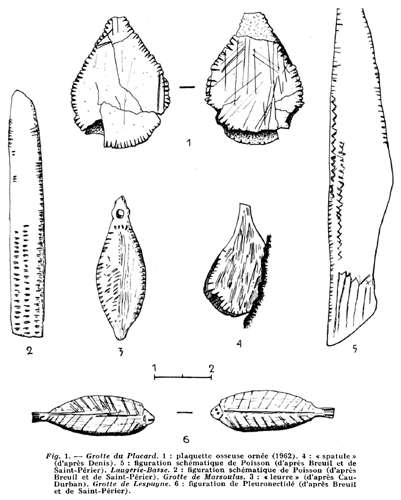
Original drawings from the paper to give absolute sizes and a comparison of sizes.
Photo: Roche (1963b)
Pierre gravée de la Grotte du Placard, Commune de Vilhonneur (Charente)
This deposit with extraordinary wealth of archaeological content was unfortunately not studied with any desirable thoroughness. It provided a wealth of artifacts, both lithic and bone, harvested from the muck that researchers were struggling to turn in every direction for years.
Early explorers were Abbé Bourgeois,J. Fermond, de Ferrière, de Maret, l'Abbé Suard, G. Chauvet, A. Masfrand etc. Operating within the working methods of their time, they have left us splendid collections of artefacts, but insufficient observations.
Regarding the stratigraphy, it would be unwise to take literally the perfect cut (after A. de Maret) published in 1906 by A. de Mortillet (Mortillet 1906) where the different levels, separated by layers of sterile debris, are stacked like a chest of drawers. The cross sections or coupes of the Grotte de Placard compiled by G. Chauvet (Chauvet 1891) and A. Masfrand (Masfrand 1902) carry differences quite evident in detail and Prof. Dr. Patte (Patte 1933) wrote with reason "we do not even have an accurate coupe of the richest layers"
Working through the literature concerning le Placard, I was struck not find anything related to engravings, whereas carved bones are particularly abundant, (Chauvet1910) and this was a gap I decided to clarify. During the years 1938-39, thanks to the kindness of Mme Joyeux, owner of the deposit, my wife and I were given every opportunity to revisit some of the rubble of the cave and search the rock piles of the exterior of the cave.
As noted by G. Chauvet (Chauvet, 1910), the animal figures are exceptional in le Placard, and here one may cite the Reindeer profile from the collection of Maret. The decoration of the old Magdalenian (I - III) which appear at le Placard is quite special and the Abbé Breuil finds "no works of art comparable to the series have yet been reported" (Breuil 1937)
While in the cave we were shocked by the previous excavations. Only one witness of previous times remained, formed from a hole that resisted all efforts to open it, and where it is impossible to extract anything without breaking it, is still in place at the entrance to the passage. However, we found part of an untouched layer covered by a rock, embedded in the floor of the cave. muck.
We collected from this place a number of fine Solutrean flints, including shouldered points, some worked bone objects of adornment and some faunal remains, all related to the Solutrean III.
The artefacts collected in the waste material comprised material from the old Magdalenian and the Solutrean, with numerous scrapers, and there were also some rare traces of later artefacts including pottery, flints, and a piece of bronze. These collections were made in such deplorable conditions that they are only of academic interest.
The presence of numerous limestone platelets derived from flaking from the roof of the cave complicated the search for stone engravings, the goal of our efforts. It would not be the first time that interesting works of art have been found in the rejects of excavations. From the mass of rubble, however, we could extract and save only the following engravings:
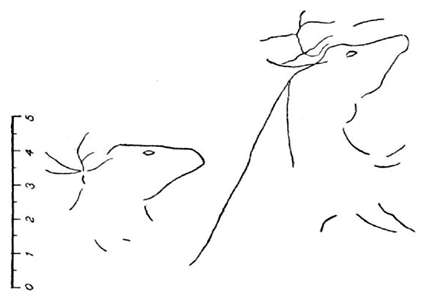
Limestone plate: 22cm x 17cm, thickness 6cm. One side was flattened by abrasion, and was coated with red ochre, and on it are engraved figures of Reindeer. The back is rough and has no drawings.
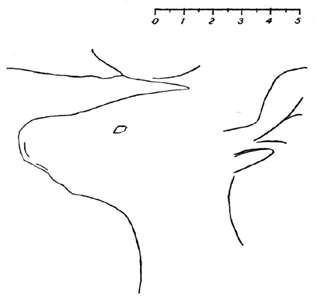
Limestone plate: 19cm x l8cm, thickness 5cm. One side bears a fine engraving of cervid. The line is stronger and more deeply incised than on the other plate. The reverse is blank. The limestone used is grainy, with a brown patina. Both of these plates belong to the Magdalenian III.
From this research one fact is now widely recognised: that engravings on stone exist at le Placard, but the genre does not appear to be highly developed. I would add that we ultimately discovered and explored part of a small terrace, at some distance from the cave, an intact Mousterian level, which will undergo further study.
La grotte du Placard
Summary: The Grotte du Placard (Vilhonneur, Charente) has given a very important stratigraphy of the Middle Palaeolithic (16 and 17 levels). The excavations enable us to determine the climatic changes over that time, with three cryoclastic levels indicating very dry and cold periods, separating warmer and wetter periods.
The Grotte du Placard, located at the hamlet of Rochebertier (commune de Vilhonneur) is carved into a middle Jurassic limestone cliff which borders the left bank of the Tardoire. It is a large chamber of roughly trapezoidal shape, 17 m long, with an average width of 9 m. It then extends in a corridor to the north which is 150 cm wide and 27 metres long.
The first excavations took place in 1853 and for a hundred years this cave was the unfortunate victim of surveys and excavations made without serious archaeological method, and without proper scientific methods or data records. This damage is unfortunately irreparable because it was a first class site for the study of the Middle and Upper Palaeolithic (Maret 1879). We have a cross section too vague to be useful, established in 1906 by A. Mortillet: at the top, the "Robenhausien", below, three Magdalenian levels, then two Solutrean levels, with Mousterian deposits at the base.
Each level is isolated by a sterile layer formed by debris fallen from the ceiling (Mortillet 1906). Despite the information gaps and because of the wealth of industries that have been harvested, the Grotte du Placard has played an important role in the history of the Upper Paleolithic, over the dispute over the respective positions of the Aurignacian, Solutrean and old Magdalenian classifications (Breuil 1907).
In 1958, the Laboratoire de Paléontologie de la Faculté des sciences de Paris, under the leadership of Professor J. Piveteau, decided to resume excavations in an attempt to describe fully the levels in place and to establish the stratigraphic succession.
Charged with this work, it became apparent to me very quickly that the central part of the cave contained only marginal strips too poor to provide useful information. However, in clearing the corridor at the end of the cave, I discovered the presence of a tunnel suspended 40 cm from the ceiling, with a length of 9 metres. It delivered the following stratigraphy:
a) At the top, very hard flowstone. Traces of the Magdalenian VI and newer industries. Thickness: 0.10 m.
b) Platelets and small limestone blocks bound together by calcite cement. Height: 10 cm to 50 cm.
c) Red-brown breccia, very hard, coating some limestone platelets fallen from the roof, as well as river pebbles carried there by man. Evidence of fauna, fireplaces and a lithic industry. Thickness: 20 cm. The industry belongs to the Magdalenian IIIb - IV with abundant burins (especially dihedrals) and scrapers, as well as backed, notched and denticulate blades, splined spears (as for the Clovis fluted or channelled spear heads, which typically have a flake taken out of each side of the base forming a channel so that a split spear shaft can be more easily attached - Don) baguettes demi-rondes, a "disque-bouton" (apparently a button for clothes - Don) and a "contour découpé", a shape cut from bone.
The latter is remarkable for its extreme rarity: it is the schematic representation of a fish, probably a Pleuronectidae (Roche 1963a). The original digging out of the cave entrance to allow freer access to the cave allowed the recovery on the northeast side of a strip of land protected by large blocks of debris dislodged from the entrance of the cave. After removal of these blocks, a longitudinal section was established along a NW-SE direction, parallel to the centerline of the cave as shown in the diagram below:
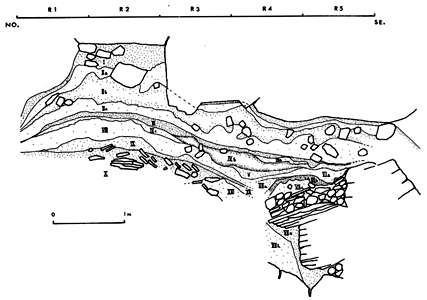
Diagram of the longitudinal coupe (cross section) from NW to SE.
Photo: Roche (1965)
Post-Paleolithic levels have virtually disappeared. Discernible locally are two surface layers (1a and 1b) containing mixed industries of the Upper Palaeolithic and Post-Palaeolithic).
There are patches of three levels of Upper Paleolithic tools which have too few tools to allow them to be classified accurately. One could assume that they date from the Magdalenian.
The most recent (IIa) probably belongs to the middle Magdalenian, the other two (IIb and IIc) to the old Magdalenian.
In marked contrast, we found a remarkable sequence of the Middle Paleolithic: seventeen levels at a maximum depth of 150 cm (levels III, IV, IVb, IVc, V, VIa, VIIa, VIIb, VIIc , VIII, IX, X, XI, XII, XIII, VIIe, VIIh).
The interpretation of the sequence is difficult because the layers are very thin (they were sometimes less than 5 cm thick) and are nested into each other in an arrangement in which the chevron tip is directed downwards at the left-right section marked as R4 at the top of the diagram.
At this point, the land has been reshaped by an animal burrow, which complicates the reading. For now, we have two stratigraphic sequences, one in the north-west, the other in the south-east, which it is necessary to reconcile.
(Thus the numbering of levels is tentative. It will be normalised when the order of the layers have been exactly determined.)
For this, it was deemed necessary to undertake a series of cross sections oriented SW-NE.
They provided little clarification because they were on the outer slope of the slope of the cave and not overlapping as thin strips where the risk of rearrangements were not negligible. In 1963 and 1964, two transects were made: one in the middle section of the R5, the other to the limits of Sections R4 and R5. They provided little. clarification because they were on the outer slope of the slope of the cave and not overlapping as thin flaps where the risk of rearrangements were not negligible. On the other hand, the coupe in the middle section of R4 in 1964 and 1965 proved highly instructive.
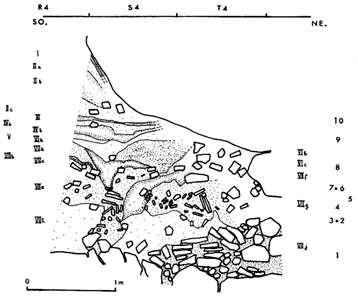
Diagram of the transverse coupe (cross section) from SW to NE. On the right, a column of figures indicating the different phases of the history of deposition.
Photo: Roche (1965)
Following an examination of the trench made in the company of Mlle Alimen, we can propose the following scheme:
I. - At the base, a cryoclastic (frost shattered) layer formed of large blocks with sharp edges, with no sediment between them. Dry cold and harsh.
II and III. - formation of sediments and consolidation phase. Climate less cold and wetter.
IV. - Cryoclastic layer formed of smaller blocks in Phase I, bound together by a little sediment. Evidence of cryoturbation (churning and mixing of deposits by frost) and probably polygonal soil. (Polygonal patterned ground is a geometric landform that develops in periglacial geographic regions, which experience intense freezing and thawing cycles). Cold period less harsh than in phase I.
V. - The phenomenon of the suction of sediment through the cracks in the floor, which had already appeared earlier, reached its maximum amplitude.
VI and VII. - Sediment formation and consolidation phase. Climate warmer and wetter.
VIII. - Cryoclastic layer formed of blocks with edges less sharp than in phases I and IV. Their position indicates a dispersed disintegration of the vault, less important and less regular than in previous cryoclastic layers. Cold period.
IX. - Formation and consolidation of the upper layers.
X. - Collapse of the canopy of the cave. The highest levels were crushed and washed away along the slope. This scheme needs to be clarified by further excavation. The study of industries, pollen analysis and those of the clays and to a lesser extent, studies of particle size and calcimetry will complete it and insert it into the chronology of the Pleistocene.
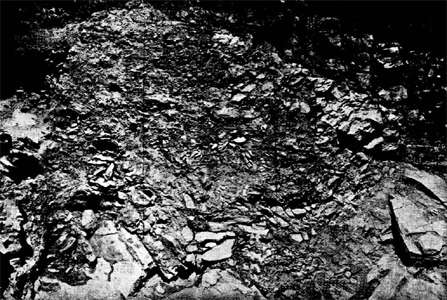
SW-NE cross-section. The gap between the lines of the grid on the photograph is 1 metre.
Photo: Roche (1965)
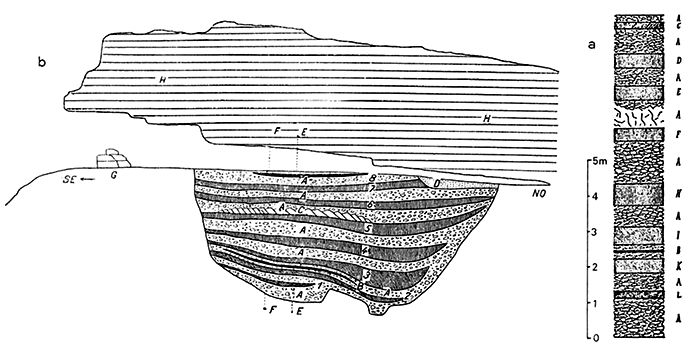
Stratigraphy of Placard
a, after Maret (1879):
A limestone scree;
B silt bed;
C limestone bench fell from the ceiling;
D stalagmite;
E coupe published in 1879;
F sondage, an exploratory trench made in the early excavations;
G large blocks of limestone at the entrance of the cave;
H limestone rock of which the cave is made.
b, after Mortillet (1906):
1 Mousterian layer;
2 Solutrean I layer ;
3 Solutrean II layer ;
4 Magdalenian I layer ;
5 Magdalenian II layer ;
6 Magdalenian III layer ;
7 Magdalenian IV layer ;
8 Robenhausien
Photo: Allain et al. (1985).
References
- Allain, J. et al, 1985: Le Magdalénien à navettes , Gallia préhistoire, 1985 Volume 28 Issue 1 pp. 37-124
- Bahn P., Vertut J., 1997: Journey through the ice age University of California Press
- Baumann, M., 2008: Exploitation des matières osseuses par les groupes solutréens du Roc de Sers (Charente, France). Master's Thesis II, L'Université Paris Ouest Nanterre
- Breuil H., 1907: La question aurignacienne. Etude critique de stratigraphie comparée, Rev. préhist., n° 6-7, 1907, 47 p.
- Breuil H., 1937: Les subdivisions du Paléolithique supérieur et leur signification, Congrès Int. Anthrop. Genève,, Genève, 1912, 2e édition 1937, 78 p.
- Breuil H. et Saint-Périer (R. de), 1927: Les Poissons, les Batraciens et les Reptiles dans l'art quaternaire. Archives de l'Institut de Paléontologie Humaine, mémoire 2. Paris, Masson, 1927, fig. 21, n° 12.
- Capitan L., Breuil H., Peyrony D., 1910: La caverne de Font-de-Gaume aux Eyzies (Dordogne), Impr. vve A. Chêne, 1910
- Cattelain P., 2004: Un propulseur inédit de la Grotte du Placard (Vilhonneur, Charente, France) Notae Praehistoricae 24-2004: 61-67
- Cau-Durban D., 1885: La grotte de Marsoulas (Haute-Garonne), Matériaux pour l'Histoire primitive et naturelle de l'Homme, 3e série, t. II, 1885, p. 346, fig. 99.
- Chauvet, G., 1891: Sur la classification des temps quaternaires, A. F. A. S., 1891.
- Chauvet, G., 1910: Os, ivoires, bois de Rennes ouvrés de la Charente, Sté Hist. et Arch. de la Charente, 1910)
- Clottes J., Duport L., Feruglio V., 1990: Les signes du Placard. Bulletin de la Société préhistorique Ariège-Pyrénées 45: 15–49.
- Clottes J., Duport L., Feruglio V., Le Guillou Y., 2010: La grotte du Placard à Vilhonneur (Charente). Fouilles 1990-1995, in J. Buisson-Catil, J. Primault (dir.), Préhistoire entre Vienne et Charente, Chauvigny, Association des publications chauvinoises (coll. Mémoire, 38), p. 345-358.
- Daniel R., 1942: Pierre gravée de la Grotte du Placard, Commune de Vilhonneur (Charente), Bulletin de la Société préhistorique française. 1942, tome 39, N. 3-4. pp. 117-119
- Denis A., 1932: Une spatule en os de l'époque Magdalénienne, Bulletins et Mémoires de la Société Archéologique et Historique de la Charente, année 1932, pp. CXI-CXIV, 1 fig.
- Dujardin, V., Tymula S., 2005: Relecture chronologique de sites paléolithiques et épipaléolithiques anciennement fouillés en Poitou-Charentes, Bulletin de la Société préhistorique française, 2005, tome 102, N. 4. pp. 771-788.
- Laurent P., 1963: La tête gravée sur bois de renne de la grotte du Placard (Charente), L'Anthropologie, t. 67, p. 563-569, 2 fig.
- Macalister, R., 1921: A text-book of European archaeology Cambridge, Univ. Press
- Maret A. de, 1879: Fouilles de la grotte du Placard, près de Rochebertier (Charente), C.R. Congr. Soc. jr. d'archéol, Vienne, 1879, 19 p.
- Marshack, A., 1972: The Roots of Civilization: the Cognitive Beginning of Man’s First Art, Symbol and Notation New York, McGraw-Hill
- Masfrand, A., 1902: Fouilles faites dans la Grotte du Placard. A. F. A. S., 1902.
- Mortillet A. de, 1906: La grotte du Placard et le niveau d'Aurignac, C.R. XXXVe sion A.F.A.S., Lyon, 1906 (1907), p. 630-642.
- Mortillet A. de, 1906: Deux curieuses pièces de la grotte du Placard, Bulletin de la Société préhistorique française. 1906, tome 3, N. 10. pp. 431-434.
- Patte, E., 1933: Les Etudes préhistoriques dans le Centre Ouest de la France. Poitiers, 1933, page 11.
- Petrognani S., Robert E., 2009: À Propos de la Chronologie des Signes Paléolithiques. Constance et Émergence des Symboles, Anthropologie XLVII/1–2 pp. 169–180 2009
- Raux P, Piel-Desruisseaux J., 1997: 'La cave à Endives' ou Le Pech del Mas à Cabrerets, Étude de la collection André David, Bulletin de la Société Préhistorique Francaise 1997, Tome 94, No. 1
- Roche, J., 1965: La grotte du Placard, Bulletin de l'Association française pour l'étude du quaternaire - Volume 2 - Numéro 3-4 - 1965. pp. 245-250.
- Roche, J., 1963a: Brèche magdalénienne de la grotte du Placard (Charente), Ann. de Paléont., t. XLIX, 1963, p. 263-281.
- Roche, J., 1963b: Os incisé provenant de la grotte du Placard (Charente)», Bull, Soc. préhist. jr., t. LX, 1963, p. 75-78
- Saint-Périer (R. de), 1928: Engins de pêche paléolithiques. L'Anthropologie, t. XXXVIII, 1928, pp. 17-22.
